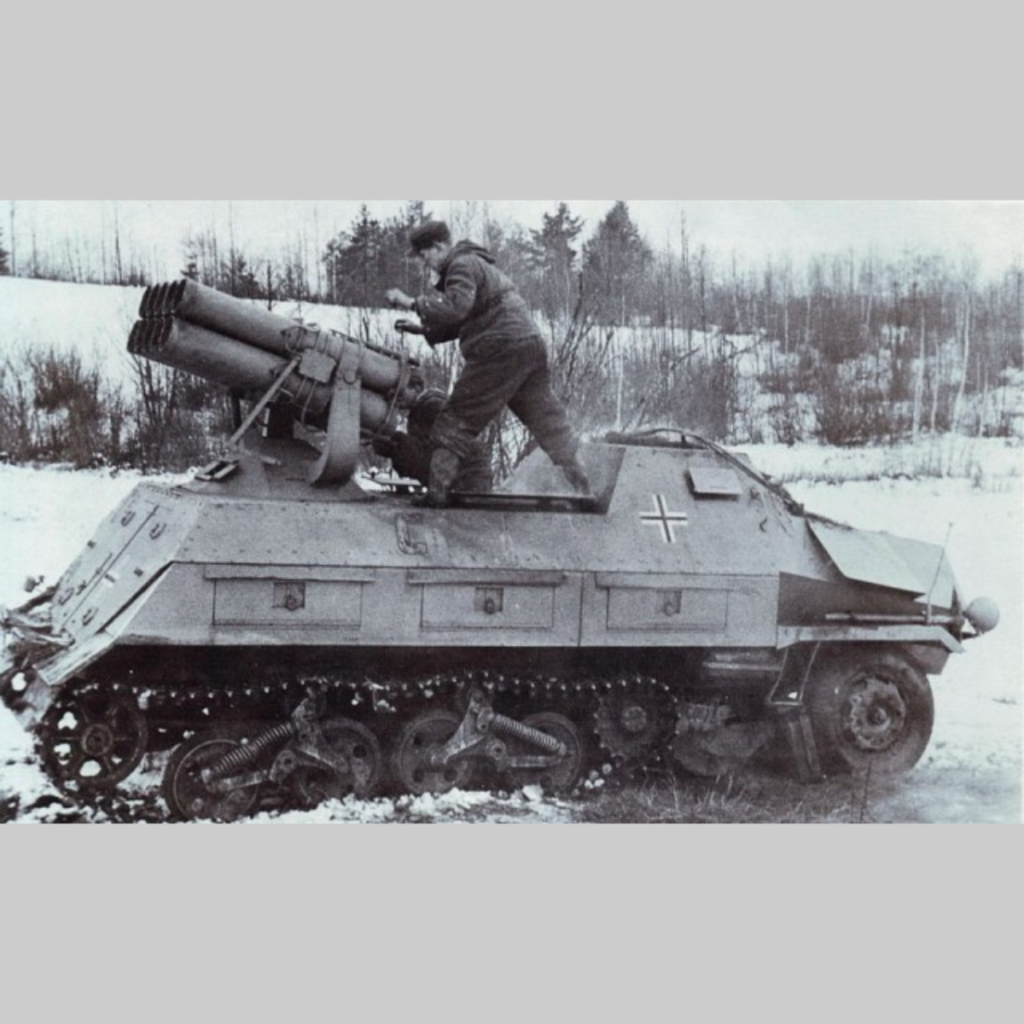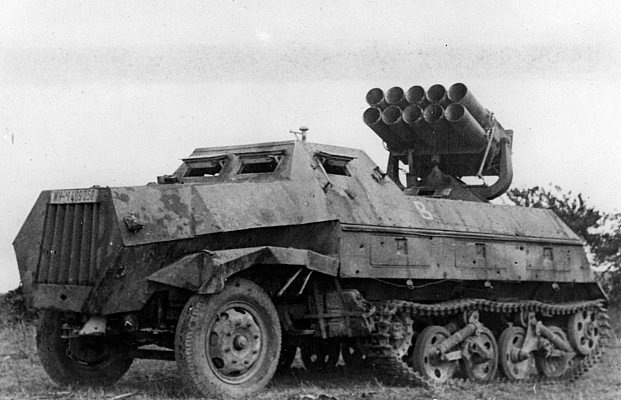
The German Panzerwerfer refers to either of two different types of half-tracked multiple rocket launchers employed by Nazi Germany during the Second World War. The two self-propelled artillery vehicles are the 15 cm Panzerwerfer 42 auf Selbstfahrlafette Sd.Kfz.4/1 (based on the Opel Maultier, or “mule”, half-track) and 15 cm Panzerwerfer 42 auf Schwerer Wehrmachtsschlepper (or Panzerwerfer auf SWS).
Two soldiers operating a Panzerwerfer in Lapland on the Eastern Front, 1944
Development
The Panzerwerfer 42 auf Maultier, Sd.Kfz. 4/1, first went into production in April 1943, and was produced until March 1945. Hitler called for production of the vehicle in January 1942, and the vehicle saw its first tests on the Eastern Front in fall of 1943. Opel was the main manufacturer, producing most of the components, including the 3.6 liter, 6 cylinder Adam Opel engine, which had 68 horsepower and an 80-liter fuel capacity. Throughout the three years it was produced, 300 Panzerwerfer and 289 of its variant, the Munitionskraftwagen, were made.

Combat history
Campaign in the Soviet Union
The Panzerwerfer 42 auf Maultier was used for larger scale rocket barrages against Soviet positions where a large bombardment of a big area would be more effective than more accurate artillery fire. The Panzerwerfer’s rocket barrages covered much larger areas and added more psychological elements to the fight: the amount of noise, smoke, splinters, and flying debris as the rockets hit and exploded was considerable. The extensive use on the Eastern Front showed that this weapon could be employed effectively on the Western Front as well. The weapon was finally introduced throughout the army on May 14, 1944, in France.

Campaign in France
The western Allies first went into action against the Panzerwerfer 42 after D-Day. American intelligence before D-Day pointed to the use of rocket launchers such as the Nebelwerfer by the German Wehrmacht, but they were unprepared for the effects of a mobile, armored, camouflaged, and highly destructive rocket launcher mounted on a half-track chassis. The British and Canadians were the first of the western Allies to see the German rocket launchers in action against troop concentrations and Allied positions. The 7th Werfer Brigade, made up of the 83rd and 84th Regiments, was sent to Normandy from Beauvais after D-Day, and on June 10 it was in Falaise; the next day, it was about 10 kilometers from Caen. The unit was part of the attack on the Orne Bridge, which was a British held position over the Orne River. The 84th Regiment of the brigade had fourteen combat ready Panzerwerfer, and the 83rd had about the same. Some other Werfer units were the 101st SS Werfer Abteilung, 101st Stellungs-Werfer Regiment, and the 102nd SS Werfer Abteilung, which was part of the 2nd SS Panzer Division Das Reich. The 7th Werfer Brigade fired 8,000 tons of ammunition, notably onto Hill 112 (during Operation Jupiter) in support of its recapture by German forces on June 30. The British were usually at the receiving end of the Panzerwerfer rockets in Normandy, but the 15 cm Nebelwerfers were used in large numbers against American, British, and Canadian troops throughout the summer of 1944.
Ardennes and Berli
The Battle of the Bulge saw intensive use of German armored rocket launchers. The most concentrated, massed salvos were used in the Ardennes region of Belgium in 1944 during the weeks of the German offensive.
Panzerwerfer saw extensive use during April and May 1945, as the Soviets were quickly advancing on Berlin and the German forces employed rocket artillery in a defensive mode. Rocket launchers were used in large numbers defending positions inside of Germany and close to Berlin as the Soviets advanced from the east and the Allies from the west.
Vehicle performance and weapon specifications
The Panzerwerfer 42 auf Maultier weighed 7.1 tonnes, was six meters long, two meters wide, and nearly three meters high. It was capable of reaching speeds of up to 40 km/h. One of these half tracked vehicles generally carried a Nebelwerfer 41 launching system, which was specially designed to be mounted on the Opel-engine powered Panzerwerfer. The German engineers designed this system because of the conspicuous trails of smoke left behind by the Nebelwerfer batteries, which necessitated a self-propelled artillery piece for quick relocation after firing. The system contained 10 missile tubes, and generally carried 20 projectiles, enough for the vehicle to fire two full salvos. The effective range for a Panzerwerfer’s rockets was about 4,000-6,500 meters, and the maximum range was less than 7,000.
Though intended to provide fire support and operate well behind the point of contact, some Panzerwerfer also had a machine gun mounted above the cab for protection against infantry attack.